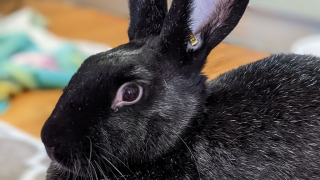
Help us make the CARE Act a reality and #SendSurvivorsHome
Moira, raised for use in a laboratory in California, was recently fostered by our North America Head of Public Affairs, Monica Engebretson, and her story illustrates the urgent need for a U.S.-wide law to ensure more animals like her get a second chance at life.
“For years, Moira was merely a number, 8904, stamped into the metal tag that was punched into her ear,” says Monica. “She was one of thousands of rabbits raised for use in a laboratory, regarded as inventory like a test tube. But then something remarkable happened. When she was no longer wanted by the laboratory, instead of being killed she was released to the care of Friends of Unwanted Rabbits, who were able to take in as many rabbits as they could find foster homes for. I volunteered, and that’s how number 8904 began her new life as Moira.”
Living conditions in the facility that Moira came from most likely consisted of rows of rabbits housed in single wire cages suspended above the ground so that their waste would fall through to the floor below. The U.S. Animal Welfare Act stipulates only the most minimal care standards. Under the Act, a rabbit Moira’s size would be afforded a cage size of just four square feet – little more than the dimensions of six sheets of printer paper. No environmental enrichment is required and likely none was provided. This environment would have meant no running, no leaping, no hiding or tunneling, no toys to investigate or items to chew – in other words, an environment devoid of the ability to fully express normal rabbit behavior.
Now Moira has free range of Monica’s office with hiding spots, a tunnel, and chew toys. She has space to run and jump and to ’binky’ – a playful twisting leap that is a signature rabbit move indicating happiness and excitement. Instead of being suspended over her own waste, she uses a litter box.
“I was surprised at how quickly Moira began to engage in the full repertoire of rabbit behavior when given the opportunity,” said Monica. “For me, this compounded the tragedy of her previous life as it suggests that being kept in such a barren, restrictive environment diminished her ability to do ’rabbit things’ but did not eliminate her desire to do them. She must have experienced near constant frustration and stress.
“It took Moira a bit longer to accept human presence and touch. At first, she would flinch and then freeze anytime I touched her, squinting her eyes, tensing her ears forward and stiffening her body as if preparing to be grabbed, lifted, and carried to an unpleasant experience. With patience and persistence, though, she learned to trust me. Now she approaches me to be petted, relaxing her ears, extending her head, and flattening her neck against the ground – a decidedly vulnerable and submissive position for a rabbit. She performs the same gesture for my cat in exchange for head licks.
“While it is highly unlikely that Moira ever saw a cat before coming to my house, she was immediately drawn to her and the two regularly play together. She has also learned to eat and enjoy a varied diet. In a typical laboratory environment, a rabbit’s diet consists of formulated pellets and nothing else. Now in addition to pellets, Moira enjoys hay, fresh vegetables, lettuce, parsley and cilantro and special rabbit treats. She loves treats and has learned that I give them out before bedtime, so at the appropriate time of day, she rushes over to me and stands up on her back feet looking expectantly for a handout.
“In preparation for adoption, Moira was spayed, and during her surgery, the embedded ear tag 8904 was removed. She will never again be regarded as just a number.”
Moira’s story illustrates the plight of the more than 130,000 rabbits used in laboratories each year in the United States and highlights the urgent need for a nationwide law that would ensure more animals get a chance at life after the laboratory.
You can help animals like Moira by asking your US Representative to become a cosponsor of the CARE Act and by promoting the bill on social media using the hashtag #SendSurvivorsHome. You can also show your support with our campaign T-shirts and hoodies.
